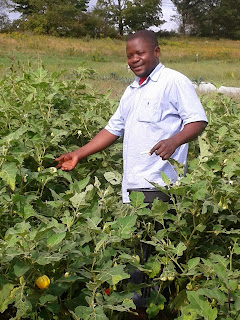I have so much to learn from the brave farmers of Fresh Start Farms. Nine farmers graduated from the training program on Friday and as each of them walked across our make-shift stage to receive their diploma, I was struck by how much each of them has learned in the three years I have known them.
Approximately half of them have made it through the rigorous process of becoming US citizens by way of passing a test about American history and laws that the average educated American adult would be hard pressed to pass without some serious studying. All of them have learned to grow many new vegetables, are figuring out how to navigate the world of wholesale produce sales, and are improving their ability to tell their customers about their farms and how to cook their vegetables. 

They are learning the best place to take their vehicles for an oil change and that they prefer the quality of red rover radish seeds from one seed company over another. They are learning how to tweak their farmer's market stands to capture the American aesthetic and that celery spaced at 12 inches produces a much better head than celery spaced at 10 inches.
They have learned so much. But what amazes me the most is the increase in literacy among this graduating group of farmers. As an educated, white American who was raised by very educated parents who enrolled me in Montessori School at the 18 months of age, I can not even begin to wrap my head around the mountainous task of learning a written language as an adult with a family in a new country and a foreign language. The vast majority of the farmers we work with are not literate in their own language. They are learning literacy in English. If you are reading this blog post, chances are, you, like me, cannot even begin to understand how challenging that is. And yet, they are doing it. Because they are determined to. Because they are 42 years old and dream of going to college someday. Because they are 47 years old and want to fill out their own tax returns someday. Because they are 60 years old and want to be able to read a check that a customer pays with. Because they are 38 years old and want to be an independent business owner someday, with no help from anyone.
Yesterday I met with Seynab Ali, pictured above in white, for an annual fall meeting to talk about how the season went and to begin some one-on-one planning for the 2014 growing season. I started the meeting with Seynab with a 15 page skills assessment: 144 skills that a farmer would need to farm independently in Maine. I ask each farmer, through an interpreter, to rank their ability to perform or understand each skill ona scale of 1 to 4. I put the thick packet of paper in front of Seynab and the interpreter started to translate the first question. Seynab stopped him. She was going to read it herself.
An hour and a half later, she had read and answered every single one of those 144 questions. There were certainly words that she needed help with, but she was reading. And more than just reading, she was understanding what she was reading. Her reading comprehension skills absolutely blew me out of the water. I had no idea that her reading had gotten so good last winter when she was taking ESOL classes nearly every day of the week. I told Seynab how amazed and impressed I was. With a big smile, she pulled a brightly colored book out of the crack in the couch cushions and said "I am practicing every night. Library book." The book in her hands was an ESOL practice book full of short stories and questions to test comprehension. She has been using that book all summer, late at night after the harvest is done, the meal is cooked, the kids are in bed, and the morning's market prepared for, to practice her reading.
To all of the farmers of Fresh Start Farms: you inspire me.





















































